Solution to Set 5: Difference between revisions
| Line 9: | Line 9: | ||
* connected with elastic springs with constant <math>K\;</math> | * connected with elastic springs with constant <math>K\;</math> | ||
* moving only in the x-direction | * moving only in the x-direction | ||
[[Image:chainatoms.jpg]] | [[Image:chainatoms.jpg]] | ||
Derive the dispersion relation <math>\omega^{\alpha} (k)\;</math> for this chain | Derive the dispersion relation <math>\omega^{\alpha} (k)\;</math> for this chain | ||
* Index <math>\alpha = 1\;</math> for acoustic branch | |||
* Index <math>\alpha = 2\;</math> for optical branch | |||
[[Image:Dispersionrelation.jpg]] | [[Image:Dispersionrelation.jpg]] | ||
Revision as of 04:02, 2 March 2009
Let's help each other, considering the importance of this HW, and get started on the solution to this thing
Diatomic harmonic chain
Problem 1
Given:
- a chain of atoms
- with alternating masses and
- connected with elastic springs with constant
- moving only in the x-direction
Derive the dispersion relation for this chain
- Index for acoustic branch
- Index for optical branch
Problem 2
Determine the speed of sound for this chain. What is the lowest frequency of long-wavelength sound corresponding to the optical branch?
From my lecture notes:
where = speed of sound
Problem 3
Sketch the motion of the atoms corresponding to the edge of the Brillouin zone, both for the optical and the acoustic branch.
Problem 4
Determine the Debye temperature for this system, and determine the form of the specific heat in the limits of high and low temperatures.
Problem 5
Consider low temperatures () and determine the wavelength of the most abundant phonons (Hint: note the analogy with Wien's Law!)












